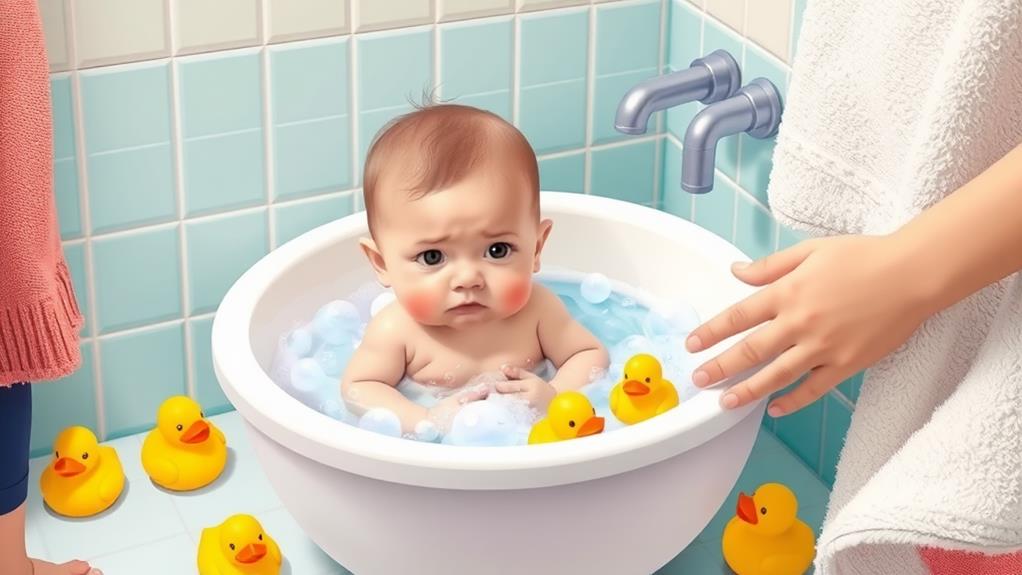If you've ever wondered why your baby seems to dread bath time, you're not alone. Many parents face similar challenges, and understanding the root causes can make a significant difference. From discomfort with water temperatures to sensory sensitivities, there are several factors that can contribute to this aversion. Timing and environment also play critical roles in shaping your baby's experience. By exploring effective strategies and insights, you could transform this daily routine into a more pleasant one. Are you curious about what specific adjustments might help turn bath time from a battle into a bonding opportunity?
Common Reasons for Bath Refusal
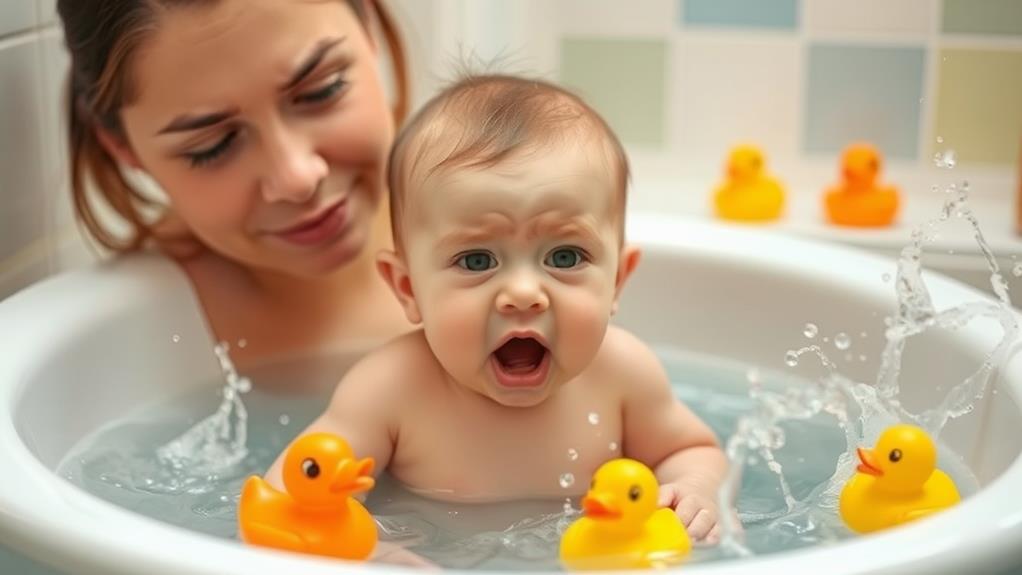
Many parents find themselves puzzled when their little ones refuse to take a bath, especially when they know it should be a relaxing routine. One common reason for this bath refusal is discomfort. If the water's too cold, it can startle your baby, making them cry and feel anxious.
Sensitivity to sensations can also play a role; splashes or soap in their eyes might create negative associations that scare them away from bath time altogether.
Another big factor is the need for security. If your baby feels unsure about slipping or not being supported well, they might hesitate to jump in. Plus, if they're tired or hungry, irritability can skyrocket, making bath time a real struggle.
Lastly, keep in mind that previous negative experiences can leave lasting fears. Maybe they were splashed unexpectedly or felt uncomfortable water temperatures before. This can create a lasting aversion to baths.
To help ease their fears, try adding toys to the water, making it a fun experience rather than a chore. With a little patience and understanding, you can turn bath time into a comforting and enjoyable routine!
Importance of Timing
Finding the right time for bath time can make a significant difference in how your baby reacts to the experience. Scheduling baths when your little one is well-rested and content is key. Ideally, choose a time of day after naps or meals to help minimize fussiness and crying. Just remember, waiting at least 30 minutes after feeding can prevent discomfort and irritability.
Keep an eye on your baby's mood before you start bath time. If they seem cranky, it might be best to wait a bit longer. Establishing a consistent bathing schedule not only helps create familiarity but also reduces anxiety and resistance over time. A predictable routine can turn bath time into a fun part of your day instead of a dreaded chore.
Also, remember that bathing 2-3 times a week is enough for infants. Excessive bathing can lead to dry skin and crankiness.
Creating a Comfortable Environment
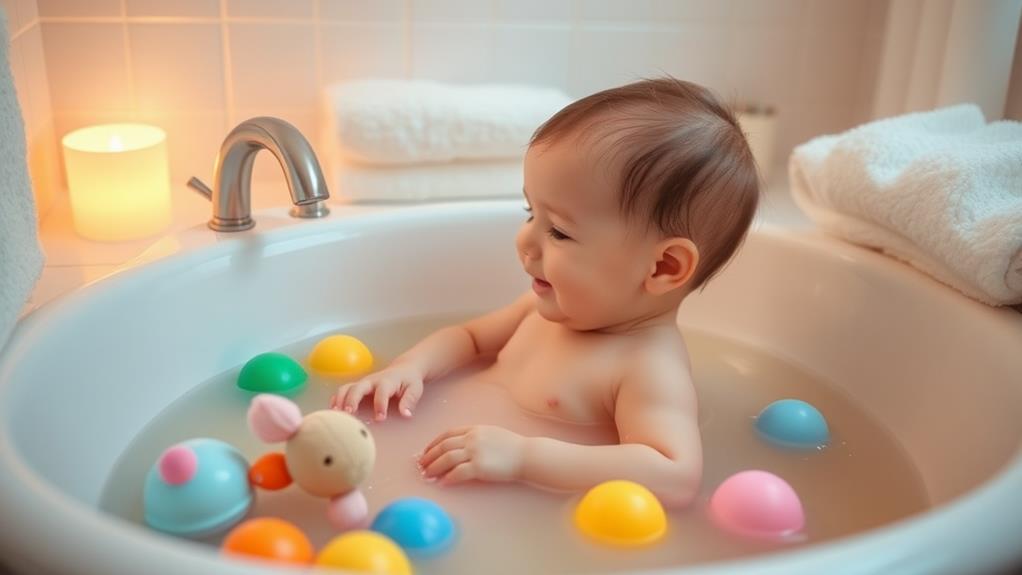
Creating a comfortable environment for bath time is essential to help your baby feel safe and relaxed. Start by making sure the bathroom temperature stays between 75 to 80 degrees Fahrenheit. This cozy environment will help keep your baby warm and happy.
When you fill the tub, use warm water that's between 98.6°F to 100.4°F. This comfortable temperature prevents any shock or discomfort when you place your little one in the tub.
To avoid drafts that might make your baby chilly, close windows and ventilators. If needed, consider using a heater to maintain that cozy atmosphere.
Creating a calming ambiance can also make a big difference. Dim the lights and play some soft music or nature sounds; this soothing ambiance can help ease your baby into bath time.
Don't forget to add a non-slip mat in the bathing area! This helps prevent slipping, letting your baby feel secure while splashing around.
With these simple steps, you can transform bath time from a dreaded chore into a delightful experience. Your little one will be splashing and giggling in no time!
Engaging Distraction Techniques
Engaging distraction techniques can make a world of difference during bath time, turning a potentially stressful experience into a fun and enjoyable one. One great way to keep your baby entertained is with colorful bath toys. Rubber duckies or floating animals provide visual and tactile stimulation, making bath time feel like playtime.
You could also sing soothing songs or rhymes; this creates a calming atmosphere and helps divert your little one's attention from any discomfort.
Another fun technique is to use a spray hose or a cup to gently pour water. This way, your baby can control the water flow, making it feel less overwhelming. Plus, introducing colorful bath crayons or foam letters can spark creative play, allowing your baby to explore and express themselves in the water.
Don't forget to incorporate familiar objects, like a favorite stuffed animal! This can provide comfort and security, easing any bath time fears.
With these engaging distraction techniques, you'll not only make bath time easier but also create lasting memories full of giggles and splashes! So, grab those toys and get ready for some fun in the tub!
Gradual Water Introduction
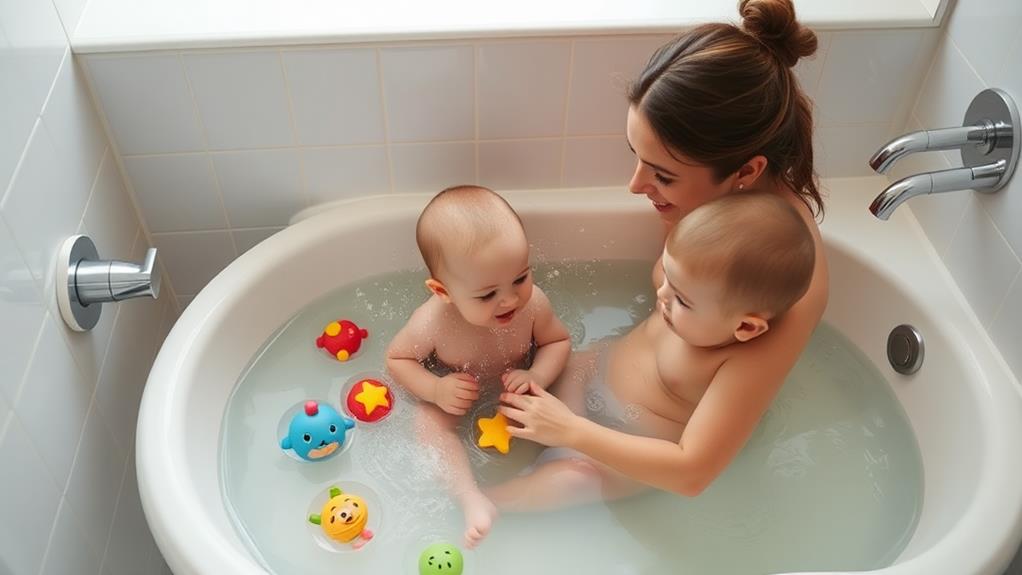
The key to making bath time less daunting for your baby lies in gradual water introduction. Start with an empty baby tub to help them feel secure before you add any water. This can ease their anxiety about the whole experience.
Once they're comfortable, pour warm water gently over their little toes. This way, they can gradually acclimate to the sensation without feeling overwhelmed.
Next, introduce running water slowly. Let your baby hear and feel it trickling, which can help reduce their fear of splashing. During this time, keep the mood light and fun! Sing songs or chat with them to create a positive association with bath time.
You can also use bath toys to make things even more enjoyable. These toys can be a great distraction, turning the whole experience into a playful adventure.
As your baby gets used to the water, gradually increase the amount and depth of water in the tub. This method helps your baby feel more at ease during their first bath, making the experience less scary and more enjoyable overall!
Alternatives to Traditional Baths
If your baby still isn't warming up to the idea of bath time, there are several alternatives to traditional baths that can help keep them clean without causing stress. One great option is sponge baths. They allow you to clean your little one without the overwhelming experience of water immersion.
You can also try showering with a caregiver. This can provide a sense of security, making bath time feel less scary.
Bringing along a favorite stuffed animal can work wonders too! The familiar face can help reduce anxiety, turning bath time into a fun experience.
If you have a small basin for rinsing, it's perfect for quick and manageable cleaning sessions. This way, you avoid the hassle of a full tub bath that might be too much for your baby.
Consider using a handheld showerhead for gradual exposure to water. Just a quick rinse can help your baby get used to the idea of bathing, easing their fears over time.
Consulting Experts and Community Insights
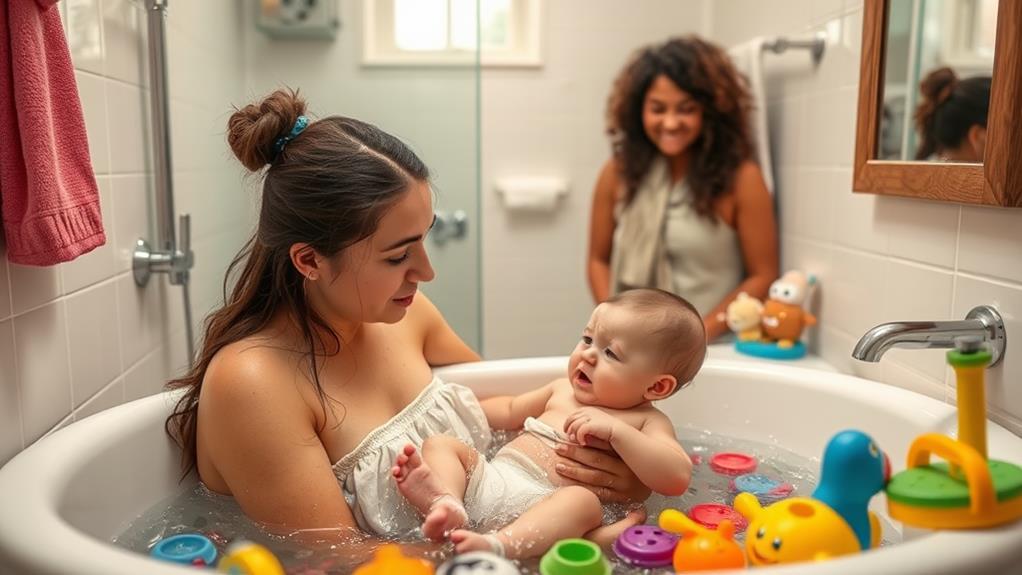
Consulting experts can provide valuable insights into your baby's bath time struggles. If your little one seems to dread bath time, consider consulting a pediatrician. They can suggest tailored bathing routines to help with any skin conditions or sensitivities that might be causing discomfort.
Sometimes, infrequent baths are just what your baby needs to keep their skin healthy and irritation-free.
Don't forget about community forums! These platforms are gold mines for parents sharing their experiences and solutions for bath time challenges. You might find tips that work wonders for your baby.
And if your child has fears related to bath time, engaging with child psychologists could be a game changer. They can help you develop strategies to make bath time less scary and more fun.
Regular check-ups with healthcare providers are also essential. They can help identify any underlying issues that might be causing bath time distress while ensuring your baby's hygiene needs are met.

